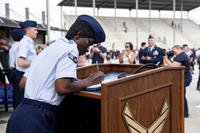The A-29 Super Tucano attack aircraft supplied by the U.S. to the Afghan air force have been used extensively since arriving in January, flying hundreds of sorties including close-air support missions, NATO's Resolute Support headquarters in Kabul said Tuesday.
"Since January, Afghan Air Force A-29 pilots have flown more than 260 sorties, supporting operational and training missions," Resolute Support said in an e-mail statement on the milestone achievement for the turboprop aircraft.
The statement did not specify how many of the sorties were operational but Army Brig. Gen. Charles Cleveland, the chief spokesman for U.S. forces in Afghanistan, said last week that the A-29s "are providing close air support." He also did not specify how many close air support missions had been flown or describe their effectiveness.
Cleveland said the first four A-29s arrived in Afghanistan in January and became operational on April 1. Another four A-29s have been delivered to the Afghan Air Force since then, he said in a video briefing to the Pentagon from Kabul.
The second group of A-29s "are now going through their paces and they are going through their training effort right now. We expect to see them become operational and we don't have a hard date for it, but we think probably the June timeframe," he said.
The Afghans have released few details on the operations of the A-29s. Last month, the Afghan army public relations directorate said 42 militants loyal to the Islamic State of Iraq and Syria, or ISIS, had been killed in a joint air and ground operation by Afghan forces in southeastern Nangarhar province, Reuters reported.
The Afghan army did not specify whether A-29s were involved in the attack. The U.S. has also supplied the Afghan Air Force with MD-530 attack helicopters.
Army Gen. John Nicholson, the new commander of U.S. and coalition forces in Afghanistan, told Reuters last month that the A-29s carried out their first independent strike operation in the northern province of Badakhshan on April 14. He said the Afghan air force was steadily improving its targeting to avoid civilian casualties.
"It's much more than just the pilot being able to fly the plane and release the ordnance -- there's a whole system that surrounds this," Nicholson told Reuters.
A U.S.-funded $427 million contract calls for a total of 20 A-29s to be delivered to Afghanistan by 2018.
Eight Afghan pilots completed training late last year on the A-29s with U.S. pilots from the 81st Fighter Squadron at Moody Air Force Base in Georgia. The aircraft, which were designed for close air support, carry a 20mm cannon below the fuselage, one 12.7mm machine gun under each wing and can also fire 70mm rockets and launch precision-guided bombs.
The A-29s began arriving in Afghanistan nearly five years after the Brazilian firm Embraer, and its U.S. partner Sierra Nevada Corp., won a Light Air Support competition with the A-29 against the Hawker Beechcraft AT-6B Texan II, leading to contract disputes and delays in the program.
-- Richard Sisk can be reached at Richard.Sisk@Military.com.



























